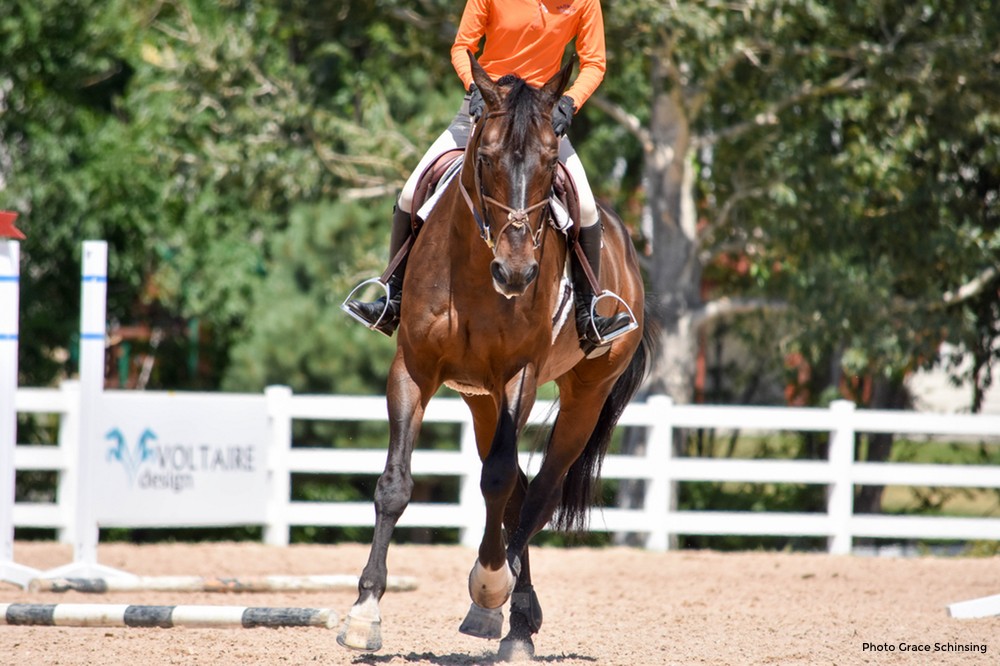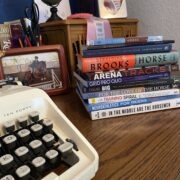Finding the Fifth Leg: Improve Your Horse’s Coordination

On a recent trip to the gym, a workout buddy pulled out the agility ladder and laid it out on the ground. Pointing at it with a smirk, she told me to get to work. I tried to oblige, but footwork has never been my strong suit. I found myself tripping all over myself as I tried to execute a simple forward-and-back effort. Suffice it to say: a future in the NFL or in the soccer arena is not in my future.
It got me thinking about footwork and how it applies to horses. Footwork, in a horse sense, has a lot to do with coordination, strength and overall athleticism. In any discipline, a horse must be able to react quickly with his feet – whether it’s to execute a precise one-tempi change or to navigate through a tricky obstacle on a cross-country course. But how does one improve this four-footed dexterity?
For starters, gymnastic exercises can be very useful for improving multiple areas of a horse’s jump, including his footwork. Gymnastics are easily used for any level of training, and are quite popular for jumping disciplines. Variations using ground poles and raised cavaletti are also much-loved by all riders.
But there are other ways to improve your horse’s coordination, professional event rider Kate Samuels of Charlottesville, Va. says. Well-versed in producing horses, Kate is a firm believer in self-awareness – a vital skill, particularly when tackling a monster cross-country course.
“For event horses, it’s especially important that they develop the proper amount of self-awareness and proprioception required to be good on cross-country when things don’t go exactly to plan, aka when you need a ‘fifth leg’,” Kate, 30, explained.
Regardless of discipline or age, though, Kate insists that her horses learn to have a good sense of where their feet are at all times. She suggests using a rope halter on a lunge line for short intervals to really drive this concept home. The rope halter is important, she says, because it doesn’t inhibit the horse’s understanding of the aids, allowing them to focus solely on their own balance.
“I take away the rider and the tack, and I do exercises at either the trot or a slow canter,” she said. “You can do simple trot poles, varying the distances for a shorter or longer stride. Place three poles on each side of the circle so the horse has to coordinate, gets a little break, coordinates again, and gets a little break. I usually start with just one pole to see how they’ll react and when they’re comfortable and relaxed I start adding more.”
It’s especially important that they develop the proper amount of self-awareness and proprioception required to be good on cross-country when things don’t go exactly to plan, aka when you need a ‘fifth leg’.
The technicality can be increased from there, Kate explains. Adding raised cavelleti or adding and subtracting strides at intervals on the 20-meter circle are examples of way to make these exercises more challenging for seasoned horses.
“With young horses I might do like 10 minutes of this four times a week, as they’re learning to jump and coordinate,” Kate continued. “This can also be easily used as a warm up before riding. You can increase the difficulty as you go along and get more creative as your horse becomes more comfortable.”
At the end, the goal is to have a confident horse with a good sense of awareness. Olympic gold medal-winning eventer Michael Jung posted a video on social media of him lunging various horses over cross-country obstacles, a practice Kate says is simply another form of teaching awareness and, by association, dexterity.
“These exercises are very similar, just in a ring,” Kate said. “I think it’s better accomplished on a circle versus in a straight line or a gymnastic because it keeps a bend through the horse’s body, which keeps him supple and soft.”


